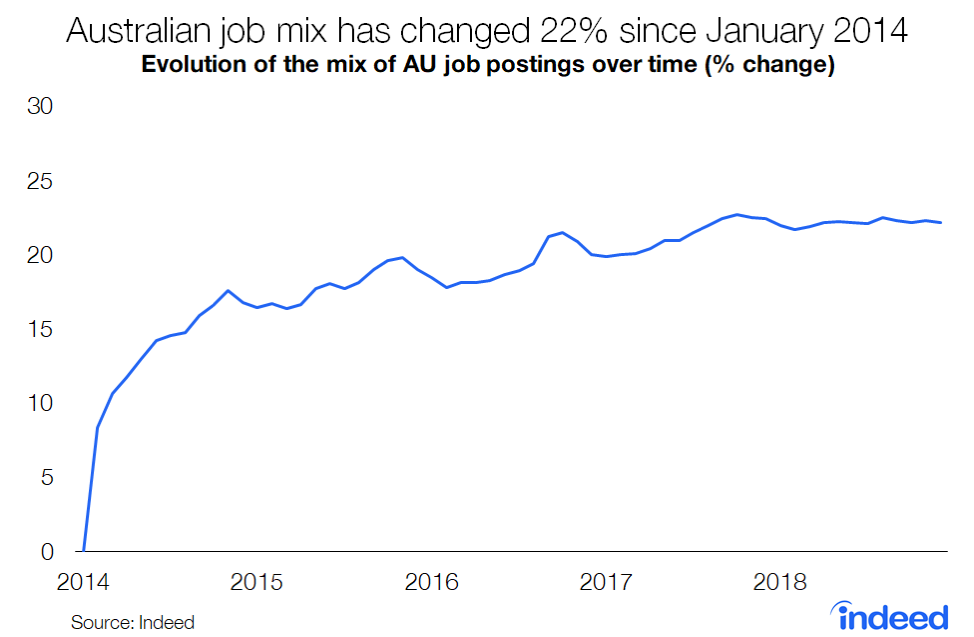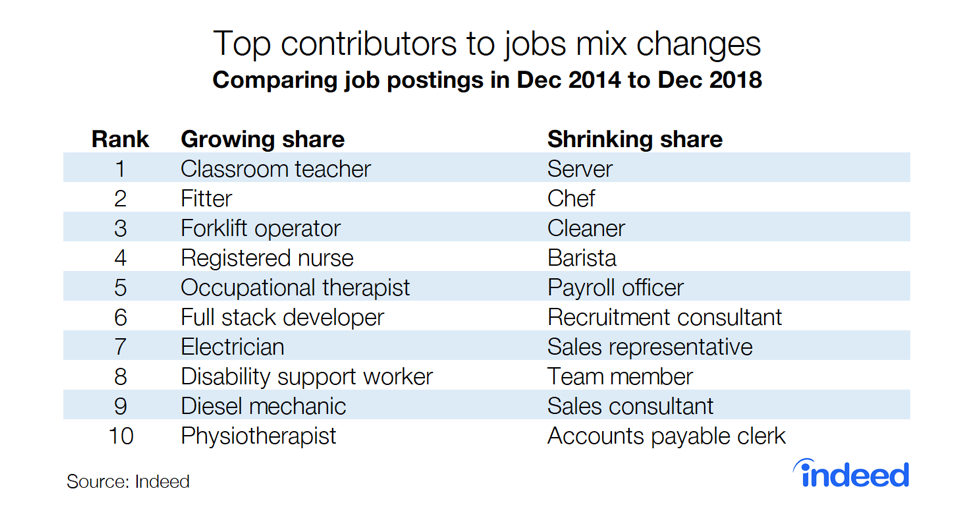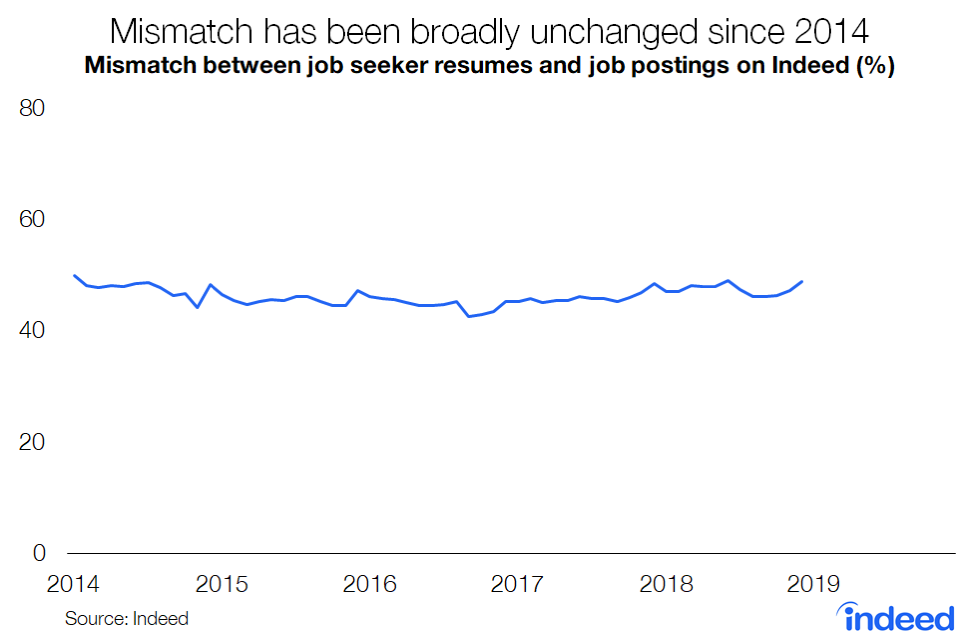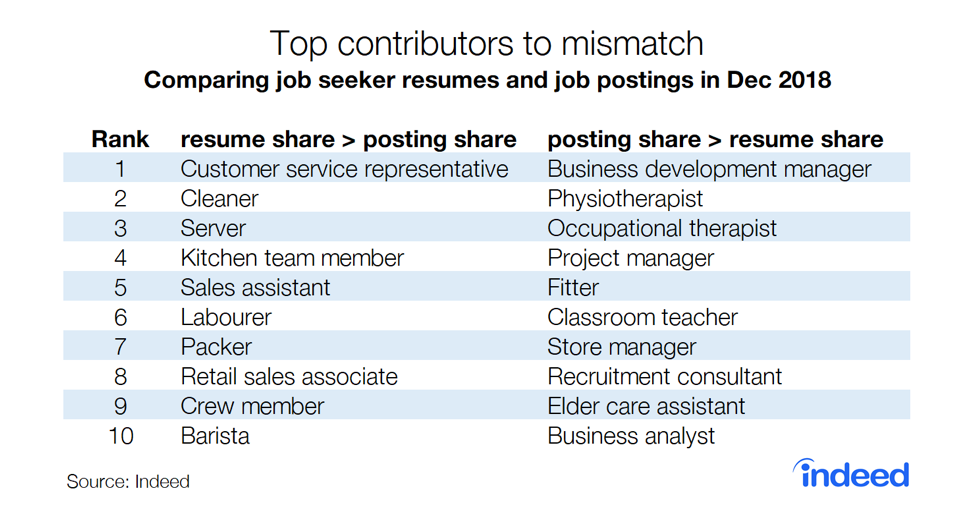Key points:
- The Australian labour market has substantial mismatch, partly reflecting Australia’s evolving job mix. Job seekers and work opportunities are aligned only around half the time.
- Mismatch indicates either relatively too few or too many job seekers per job posting. Typically, positions with higher educational requirements struggle to find qualified candidates, while workers seeking jobs with lower educational requirements often face a lack of opportunity.
- Overseas job seekers gravitate toward occupations with higher educational requirements, potentially alleviating the impact of mismatch in those categories.
Australia’s labour market is constantly evolving. Some occupations emerge, others fade, and the skills in demand regularly change. The distribution of job opportunities across Australia’s economy has changed around 22% over the past five years. Such a shift in the job mix can give rise to skill shortages or mismatches between job opportunities and job seekers, which can harm businesses and job seekers alike. Businesses may lower expectations for skills or experience, while job seekers might accept positions that fail to fully utilise their skills or education. Australia struggles with mismatch more than other advanced economies.
Using Indeed’s job posting and resume data, we examined how fast the mix of job opportunities is changing and whether Australian job seekers are keeping up. We found:
- Australia’s labour market is evolving, with the job mix 22% different in December 2018 than in January 2014.
- Job opportunities and job seekers are aligned only around half the time. Mismatch in Australia is much higher than in comparable countries, such as the United States and the United Kingdom.
- A variety of factors explain mismatch. Higher-skilled roles tend to attract comparatively few job seekers, while lower-skilled workers often face relatively limited opportunities.
- Overseas job seekers tend to gravitate toward occupations with high educational requirements, potentially alleviating mismatch in those categories. Job seekers from abroad are less interested in occupations with lower educational requirements, where competition from domestic job seekers is greatest.
How fast is the Australian labour market changing?
To examine how quickly the Australian labour market is changing, we compared the mix of job titles in Indeed job postings in December 2018 against the mix in January 2014. Employers use many different job titles for the same type of work, so we group similar titles together under a single designation. For example, ‘teacher’ includes a range of primary and high-school teaching roles. (See methodology for more information.)
In December 2018, Australia’s job mix had changed 22.2% over five years. That level of change was slightly less than in the United States (24.1%) and the United Kingdom (25.3%).

Some occupations have thrived since 2014, while others have struggled. The table below shows the job titles that have contributed most to the changing job mix.
When we think about Australia’s evolving labour market, we often focus on cutting-edge occupations in the tech sector, such as data scientist. And it’s true that some tech jobs, such as full stack developer and .net developer, are strong contributors to Australia’s shifting job mix. Nevertheless, more traditional occupations are driving the changes in Australia’s job mix. Blue collar roles such as fitter, forklift operator, electrician, and diesel mechanic are among the fastest growing occupations. Jobs in the care sector also rank high, such as registered nurse, occupational therapist and disability support worker.

Overall, jobs have grown over the past few years. So a job title with a declining share has not necessarily registered an absolute drop in the number of opportunities.
In addition, results for specific job titles aren’t necessarily representative of the broader category in which they fit since each title is defined narrowly. Teaching has been one of the country’s strongest-growing sectors over the past four years. But some teaching occupations, such as preschool teacher and music teacher have declined in posting share.
How well are job seekers keeping up with the changing job market?
To measure mismatch across the Australian labour market, we compare the titles of active job seekers’ current or most recent jobs sourced from their resumes with the titles of Australian job postings.
Three findings stand out:
- Mismatch is substantial. Almost half of job seekers would need different job titles on their resumes in order to have the same distribution as postings. Currently, many job titles have lots of job seekers but relatively few openings, while some have lots of vacancies but relatively few applicants.
- Mismatch in Australia is much higher than in comparable countries. It is around one-third in the United States, less than one-third in Canada and 40% in the United Kingdom. Labour market slack in Australia is currently higher than in those countries, suggesting that higher mismatch might be associated with greater job market weakness.
- From 2014 to 2018, mismatch in Australia was broadly unchanged.

Some vacancies are harder to fill, while others are relatively easier. For example, our data suggest it is especially difficult to fill openings for business development manager or physiotherapist than for customer service representative or cleaner.
The jobs with the greatest gap between posting and resume share tend to be those with higher educational requirements. That is no surprise since those roles often require or favour workers with formal qualifications. Job qualifications act as a barrier that limits the range of workers who can apply. Meanwhile, the jobs for which resume share exceeds posting share tend to be positions with lower educational requirements.

A previous post looked at the shortage of registered nurses in Australia. This mismatch analysis bears that out. Registered nurse is not among the occupations with the greatest mismatch. Still, its posting share exceeds its resume share, which helps explain the persistent shortages hospitals face across the country. Other healthcare occupations, such as physiotherapy, also rank high.
Occupations for which posting share exceeds resume share are typically higher skilled. Such occupations also generate more interest from overseas job seekers. In the second half of 2018, almost 13% of searches for jobs in the right-hand column of the table above were from overseas. That compares with around 8% of searches on all job postings and less than 4% of searches on the jobs in the left-hand column. Skilled job seekers appear more likely to search abroad for work. Therefore, searches from outside Australia mitigate mismatch between opportunities and local talent.
Interest in Australian jobs from overseas is not lacking. For Australia, the key question is whether those job seekers can get a skilled VISA. The hurdles to gaining a VISA are higher now than they were a few years ago.
In Australia, job seekers and work opportunities are less aligned than you’d think. As a result, employers are often forced to compromise in terms of skills and experience, while job seekers frequently must accept work that doesn’t fully use their skills. A cross-country analysis shows mismatch in Australia is higher than in comparable countries. Australia faces a considerable challenge narrowing the gap between job seekers and work opportunities.
